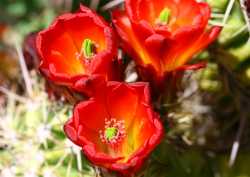Plants few to many branched. Stems usually erect, cylindric, 10-40 × 5-10 cm; ribs 8-13, slightly undulate; areoles 10-15 mm apart. Spines [8-]9-18 per areole, straight or contorted; radial spines 7-14 per areole, appressed, yellowish to brownish, becoming gray, 5-25 mm; central spines 1-4 (c Arizona and Mexico) or 3-8 (elsewhere) per areole, spreading to projecting outward, brownish yellow to reddish black, becoming gray, terete (c Arizona) or angled to terete (elsewhere), 15-50 mm. Flowers 5.5-7 × 3.5-5 cm; flower tube 25-35 mm; flower tube spines 5-15 mm, hairs to 2 mm; inner tepals bright orange-red to dark red distally, proximally paler (bases sometimes yellow or whitish), 25-40 × (5-)10-15 mm, tips thick and rigid; anthers pink to brick red or purple; nectar chamber 6-10 mm. Fruits green, brownish tinged, 20-30 mm, pulp white. 2n = 22.
Flowering Apr-May; fruiting May-Jul. Chihuahuan Desert, desert scrub, interior chaparral, desert grasslands, steep walls of canyons, limestone hills, among granite boulders; 1400-1900 m; Ariz., N.Mex.; Mexico (Chihuahua).
Some populations of diploid claret-cup cacti in southeastern Arizona and southwestern New Mexico have recently been named Echinocereus arizonicus subsp. nigrihorridispinus W. Blum & Rutow, including numerous eastern populations previously misidentified as other taxa. Subspecies arizonicus, of conservation concern, remains known only from central Arizona. Infraspecific taxa within E. arizonicus are not treated formally here because their taxonomic boundaries remain controversial.
Echinocereus arizonicus superficially resembles the dioecious tetraploid E. coccineus var. rosei of the Chihuahuan Desert, and several of its populations were mapped by L. D. Benson (1969, 1982) as part of E. triglochidatus var. neomexicanus (Standley) Standley ex W. T. Marshall. Echinocereus arizonicus subsp. nigrihorridispinus superficially resembles the partially sympatric, synoecious tetraploid recently named E. santaritensis W. Blum & Rutow (a hermaphroditic geographic race of E. coccineus), which has much longer hairs on the flowers, a narrower flower tube, and relatively slender spines. Irrespective of the misleading vegetative similarities between diploid E. arizonicus and its polyploid relatives, E. arizonicus differs strongly from both varieties of the diploid E. triglochidiatus.
Common Name: Arizona hedgehog cactus
Duration: Perennial
Protected Status: Endangered, highly safeguarded.
General: Few to many branched with erect and cylindric stems 10-40 cm long and 5-10 cm in diameter, slightly undulate. Generally appearing stout with a few large, clumped branches.
Spines: Central spines 1-4, dark gray with 7-14 pinkish-tan radials, appressed and 2.5-4 cm long, becoming gray with age but generally straight, occasionally contorted.
Flowers: Broad about 5 cm diameter and 5.5-7 cm long, the inner tepals bright orange-red to dark red at the tips with bases that are sometimes yellow-green.
Fruits: Green, yellow, or pinkish with bright red to brownish tinge, 20-40 mm long with white pulp.
Ecology: Found on limestone hills and among granite boulders in the Chihuahuan and Sonoran deserts in desert scrub, from 3,500-5,000 ft (1067-1524 m).
Distribution: se AZ; sw NM; n MEX.
Notes: Currently accepted as a variety of the E. coccineus complex. Distinguished by being erect and branching, with many stems jointed at the base forming clumps (caespitose); 8-13 ribs; the central and radial spines are shorter, 15-50 mm but mostly ca. 20 mm (triglochidiatus: 50-120 mm, coccineus 10-80 mm) and stouter than most of the other varieties in the region; the flowers are monecious (fertile stamens and pistils in one flower) flowers red with inner tepals carmine.
Ethnobotany: No specific use of the species recorded, however the fruits of the genus were used as food.
Etymology: Echinocereus is from the Greek echinos, hedgehog or spine and cereus, waxy, while arizonicus means of or from Arizona.
Synonyms: Echinocereus coccineus var. arizonicus, Echinocereus polyacanthus var. neomexicanus, Echinocereus triglochidiatus var. arizonicus, Echinocereus triglochidiatus var. neomexicanus
Editor: LCrumbacher 2010, FSCoburn 2015









